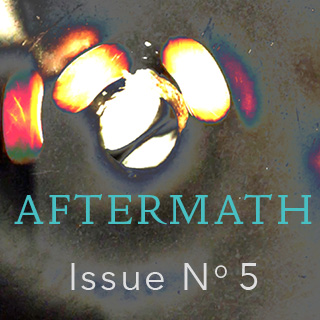Perhaps if I were capable of taking a clinical view of recent events, I might be excited by all that could be learned about what happens to the human mind in the wake of unexpected calamity.
CONTENTS
Editor’s Note
Aftermath Stories
Leave Your Drawings in this House
Fandanguillo
The Enormity
For instance, I’ve noticed that my thoughts—by which I mean both the articulate and inarticulate movements within our minds—tend these days to lurch in ways that make little sense to me. The walls of the dykes of expectation and order have been breached. The canal has been overtopped. The waters of the flood sit over the land, and they will go where they choose to go.
There is no port, there is nowhere to go
only the deepening black darkening still
blacker upon the soundless, ungurgling flood
darkness at one with darkness, up and down
and sideways utterly dark, so there is no
direction any more
But every so often, I find something to cling to, which at least gives me a sensation of movement toward something—possibly an unseen shore. The quote above, for example, carried me for a time with its luscious, almost enticing portrait of oblivion. It’s from “Ship of Death,” by D. H. Lawrence, a poem I have long loved and deliberately reread on the day after the election.
Another piece of floating wreckage came to me unbidden in the first hours of November 9 and has carried me through to this day. It was a simple sentence that at first had little apparent meaning.
“This is not the worst; the worst is yet to come.”
The words recurred as I lifted a coffee mug, as I slowed my car before a clot of traffic, as I looked up, garbage bag in one hand, hoping to glimpse stars. It took a while before I realized where they came from.
“This is not the worst; the worst is yet to come.”
What meager comfort they seemed to provide at first. Indeed, they could almost be a threat. Imagine your torturer stroking rusty shears while he mutters those words. But, for some reason, I felt strength in them.
“This is not the worst; the worst is yet to come.”
The line is from an illustrated book I have read dozens of times with my children, and to be honest, I hadn’t before paid much attention to it. In the moment of reading, I’d had so much else to distract me: the elegant vermilion and gold drawings; the sweep of the story; the strangeness of folk tale logic; the delight of my children. I do remember stumbling over those words, intrigued by the use of pessimism as encouragement, but I never stopped to sound them to their bottoms. Now, why did I keep hearing them?
“This is not the worst; the worst is yet to come.”
The line recurs several times in the book, which is a retelling of a slavic folk tale called The Firebird. It is spoken by a horse. (See “folk tale logic,” mentioned above.) This horse is the “horse of power” belonging to Dimitri, the hero of the story. Each time, the horse speaks the line to comfort Dimitri after the “hero” has gotten himself into a pickle by doing something the horse had previously warned against.
“This is not the worst; the worst is yet to come.”
But the words do more than comfort. The horse seeks to rouse Dimitri out of his despair, to get him to man up and take on the next challenge. In this sense, the meaning of the line is that the present moment only becomes the worst, the nadir, the end, if you give up—if you let circumstances destroy you. But why should Dimitri get up, only to face something worse? If you fight on, yes, you will encounter worse moments… but by fighting on, you keep the very worst (ie, hopelessness and defeat) perpetually at bay, bottled in the future. There may be little joy in this logic, but there is the power to make a choice.
“This is not the worst; the worst is yet to come.”
Perhaps that is meager comfort. But it works well in the story, which ends with Dimitri becoming czar and marrying the fairy princess. The horse gets a nice pasture. It’s happily ever after all around. I am not really hoping for a storybook ending (unless you have a “horse of power” you haven’t told us about; and, if you do, I wish you had deployed it before the election). But in the churn of events, even when we’re knocked down, we can resolve to move forward with determination and dignity. We can lift ourselves out of despondency simply by moving actively into the future. This issue is a result of such an effort.
When we put out the call for stories, poems, and reflections on the theme of aftermath, the thoughts above had just started taking form. I can’t separate their current elaboration from what I learned as I read through the hundreds of thoughtful and deeply felt submissions we received. There was a sense of shared meaning, as if a hundred minds could be working at the same thought, the form of which could only be revealed by stepping back and viewing many artists working at once. There were also moments of serendipity, when the alignment of images, language, or thought from disparate sources revealed a sudden energy of potentiality. It was a privilege to experience and be moved by these stories. We hope that reading this issue will bring you some of the same succor we experienced.
“This is not the worst; the worst is yet to come.”
The Editors
The Editors wish to thank all of the writers and artists who have contributed to this issue. We are deeply grateful to be facing the future together with you.
READ THE REST OF ISSUE NO. 5.
CONTENTS
Editor’s Note
Aftermath Stories
Leave Your Drawings in this House
Fandanguillo
The Enormity




